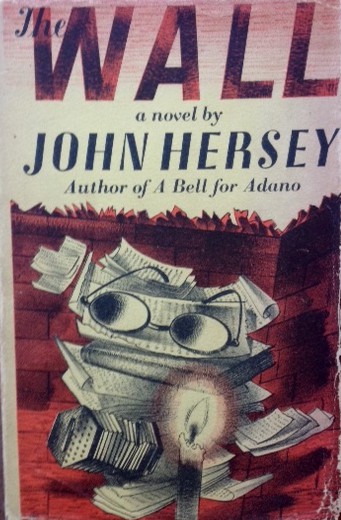Inspiring Older Readers
 posted on 12 Apr 2019
posted on 12 Apr 2019
Classic Covers: The Wall by John Hersey
I don’t think I’d lose too much money on betting that most readers of this article wont have read John Hersey’s 1950 novel, The Wall. Indeed, the chances are you’ve never heard of it or its author and I suspect I can add the creator of the book’s jacket, Barnett Freedman to that list of unknowns too. Hersey’s novel is a bit of a saga, a brick of a thing that tells the story of the Jews in the Warsaw ghetto from the onset of World War Two through to its destruction in 1943. Hersey tells his story through the vehicle of three families as their fortunes fluctuate and tragedy closes in around them.
John Hersey is probably best known for his 1946 publication, Hiroshima which is now thought of an early example of ‘new journalism’ and on this site we have featured a review of his dystopian sci-fi novel My Petition for More Space. Neither of these can boast a jacket to match The Wall however, despite being, in my opinion, better books.
Barnett Freedman’s outstanding book jacket designs for Faber and Faber are now considered classics of the art. Born in 1901, Freedman was the son of Jewish immigrants and grew up in London’s East End before getting himself a scholarship to attend the Royal College of Art. His big break came when he was commissioned to do the artwork for Siegfried Sassoon’s Memoirs of an Infantry Officer in 1931. In addition to line drawings within the text and full page colour plates, Freedman designed a fully integrated wrap-around jacket to supplement dramatic design work on the endpapers. He was soon in demand for a range of commercial graphic design and started working with printing houses famed for their design ethos – the Curwen Press, Baynard Press and Chromoworks.
Along with Edward Bawden and Edward Ardizonne, Freedman was appointed as an official war artist and after the war he returned to his commercial work and continued book jacket design for Faber. His jacket design for The Wall in 1950 is typical of both his style and technique with another full wrap-around design. The details are both complicated and simple at one and the same time. The backdrop is a depiction of the ghetto wall in front of which hover a miscellany of items – papers, spectacles, a concertina/squeeze box – all of which have significance to the saga being told. In the forefront is a luminescent candle casting the light of hope on the whole assemblage. Cleverly Freedman has put this design together in such a way that these seemingly random items take on a wary, even frightened, anthropomorphic identity with shadows behind the spectacle lenses giving the impression of eyes looking furtive or askance.
Freedman’s health after the war was always delicate and he died an early death at the age of just 56. Fortunately there are plenty of great examples of his jackets out there on collectable (but not terribly expensive) vintage Faber publications. Keep your eye open for them in second hand and charity shops and try snapping them up while you can because you wont be disappointed.
Terry Potter
April 2019


